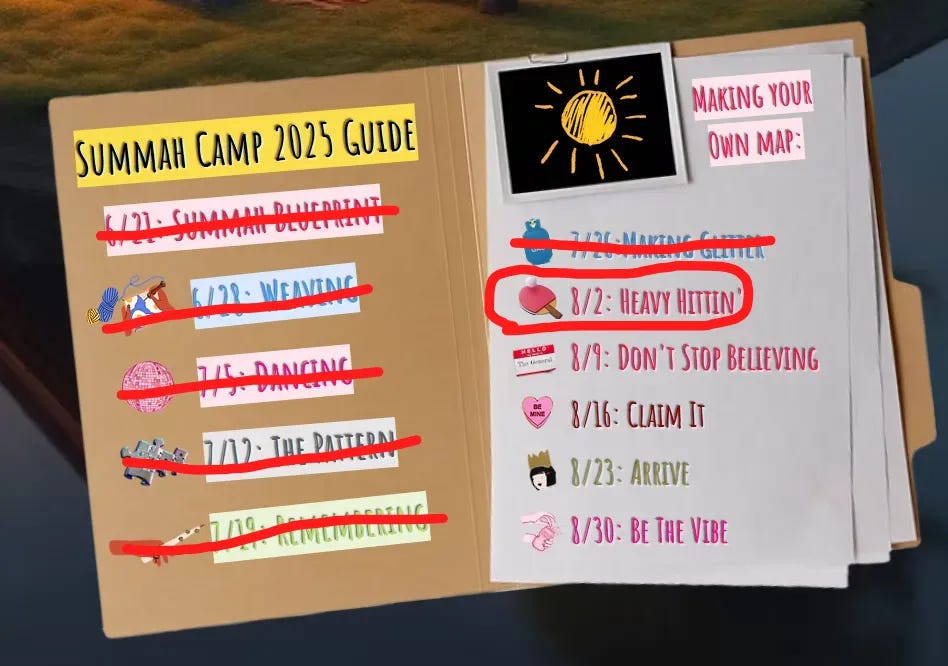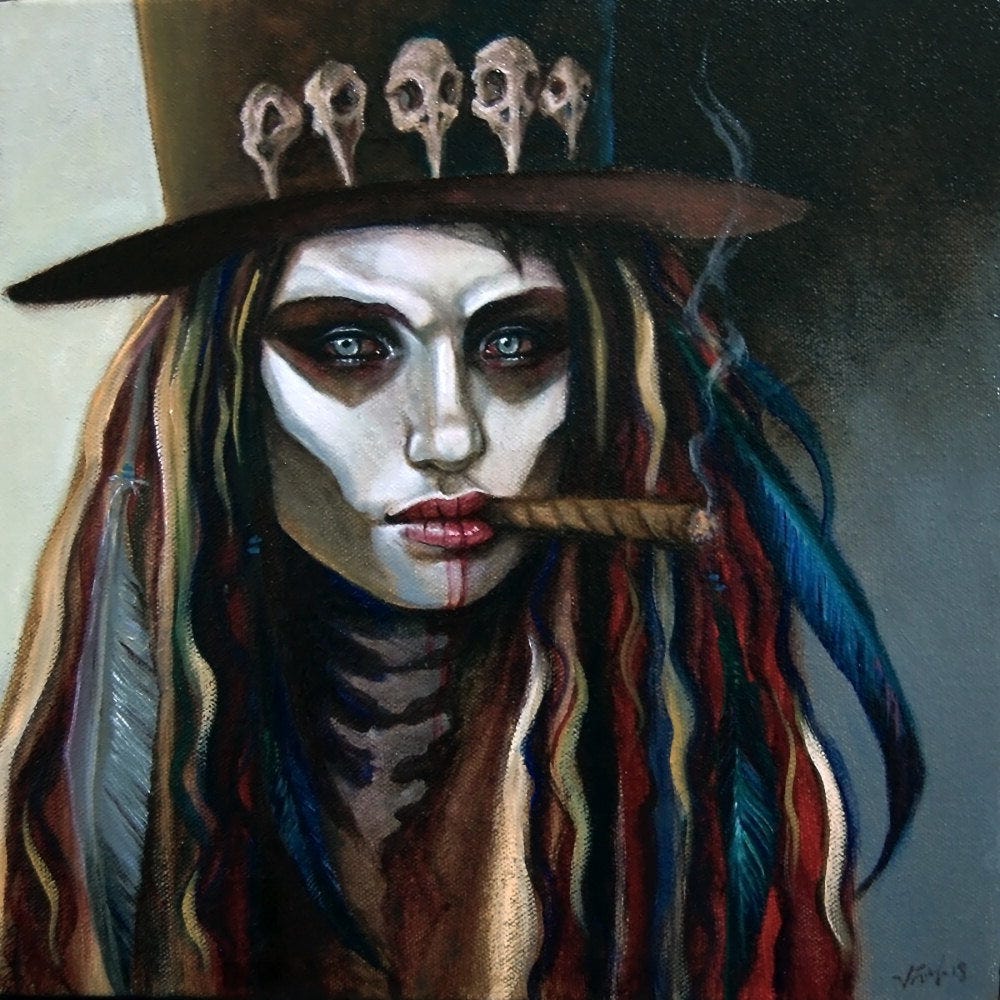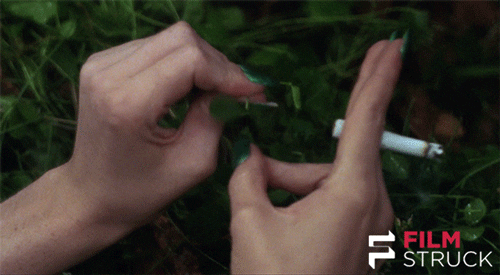Welcome to the Motherland
Burn your bras and grab your rosary beads.
Witches, evil queens, good wives + lion cubs,
My great-grandmother’s name was Brigid. Legend says she was a witch, but I think she just had a gift for pattern recognition and intentional storytelling.
It’s a tradition that runs through my ancestral line, and it’s been used as a survival practice for generations. I’ve traced it all the way back to the Irish Famine that wasn’t really a famine, but we’ll talk more about that another time. *jazz hands*
I never met my great-grandmother, but her memory was always present. My nana idolized her, my father feared her, and anyone who knew her told me I was just like her.
Today, I’m excited to introduce you to her namesake — the original Brigid.
Welcome Back to Summah Camp!
A weekly storytelling series about rewriting our lives through pattern recognition and mythmaking. If you’re new, start with the syllabus then choose your own adventure.
I’m the Mahvelous Ms. B — former teacher, current human. I’ll be your tour guide this season as we journey through the deep end together.
This week’s episode is: Heavy Hittin’. Let’s dive in. ⬇️⬇️⬇️
Celtic Mythology 101
Celtic mythology is one of the oldest story systems in Europe, with roots dating back over three thousand years. These stories primarily developed across the regions we now know as Ireland, Scotland and Wales.
Our focus will be on the Irish canon — it’s where my roots are, and it holds the most complete body of surviving texts. Much of what we know today was written down after Ireland’s conversion to Christianity, when monks became the record-keepers.
As they documented the oral tradition, they carried with them the priorities of the Church: order, obedience, and male authority. Stories changed shape in their hands, and many female figures were erased, diminished, or rewritten to serve religious goals.
What had once preserved memory and meaning was gradually reshaped to maintain dominance.
However, Ireland lived by a different set of truths before the Church’s rise to power. Irish paganism was a land-based spiritual system that honored nature, ancestry, and the unseen.
It was rooted in feminine power, offering guidance through stories that built connection and shaped a worldview grounded in natural rhythm. Order came through reciprocity, rather than control.
Brigid is one of few Irish figures whose presence remained intact. She appears across traditions as a Celtic goddess, a Christian saint, and even the Voodoo guardian of the dead. Her story takes many forms, but her role remains constant.
She creates, she protects, and she guards the threshold between worlds.
Goddess Brigid
Brigid is said to have created Ireland with her bare hands. In the oldest stories, she isn’t limited to one role. Some versions split her into three sisters: a poet, a healer, and a blacksmith. But that’s just a way of explaining what couldn’t be contained.
As a poet, she offered blueprints for living. Her words preserved wisdom and shaped legacies. As a healer, she drew knowledge from the land to ease pain, guide birth, and care for the dying. And at the metal shop, she started fires, crafting tools that built homes and the weapons that protected them.
Brigid didn’t settle into one path. Instead, she chose to walk all of them because it’s what life required. She became what was needed, again and again, leaving behind a world that could stand on its own as a result.
She turned survival into an art form and passed it on.
Saint Brigid
As a Christian saint, Brigid is remembered for providing protection, performing quiet miracles, and supporting people through times of need. Her legacy endures because she made faith feel practical by rooting it in presence and everyday acts of care. She was also quite unhinged. It’s the best thing about her.
One story tells the tale of a young girl who becomes pregnant after breaking her vow of chastity. Afraid and unsure of what to do, she turns to Brigid for help. In the greatest plot twist of medieval times, Brigid laid her hands on the girl and the pregnancy vanished. There was no pain or punishment — just compassion, care, and release. Interesting, right?
Another time, she was at an Easter gathering and they ran out of drinks. You want to know what the second-best miracle of all time was? Brigid turning bathwater into beer for the entire party.
She was a master at performing ordinary interventions that restored balance and faith.
Maman Brigitte
Brigid’s story didn’t end in Ireland. During the 17th and 18th centuries, Irish indentured servants were brought to the Caribbean and North America by colonial powers. Many worked under harsh conditions, often alongside enslaved Africans. In those spaces, survival demanded adaptation and people held tight to what was in their control — songs, symbols, and stories.
Over time, Irish folklore, Christian tradition and West African spirituality began to intertwine, creating a new practice. Through that cultural blending, Brigid took new form as Maman Brigitte. Known for her quick wit and fierce devotion, she drank her rum with hot peppers, swore like a sailor, and refused to tolerate injustice.
She served as a fierce protector of women and the madame of the underworld, working beside her husband, Baron Samedi — a spirit known for his dark humor, disruptive energy, and raw truth-telling. When all other options were gone, Maman Brigitte was the one you called. She stood watch at the threshold between life and death, offering healing when possible and guiding the rest to the afterlife with dignity.
She led with love, fought with fire, and never left a soul behind.
Brigid exemplifies the beauty of cultural diffusion, and what can happen when we choose to keep going during times of despair. Her shape has changed, but her purpose has not. She creates what’s needed, protects what matters, and fosters safe spaces in the harshest conditions.
That’s the Brigid I recognize in my great-grandmother. Over time, the stories she carried became the stories she embodied. She passed down a way of seeing that held pattern and purpose side by side — and somewhere along the way, I picked it up.
When my entire world fell apart, it was Brigid’s stories that held me when nothing else could. She reminded me that carrying your full self with confidence is one of the greatest acts of self-love there is. In a world that keeps trying to shrink us down, celebrating authentic wholeness becomes its own kind of poetry.
And that kind of poetry? It's resistance. La Vie Boheme, y’all. As always, take what resonates and leave the rest. See ya next week!
<3 The Mahvelous Ms. B
PS. Click here for this week’s mixtape. Just when you think you’ve got me figured out, the season’s already changing! Also, for a second, I forgot I was a —
** Always free, no ads + we’ll never share your email. Learn more here.









